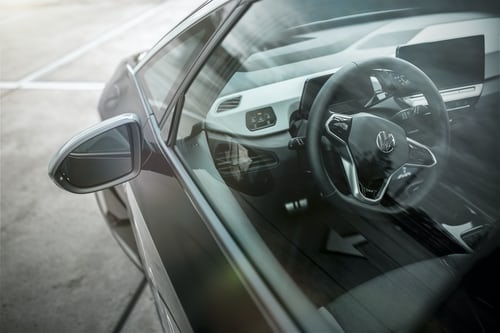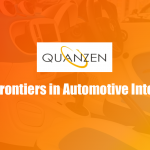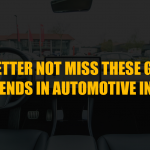How Technology Trends are Revolutionizing the Automotive Interiors
A revolution is underway that could allow your living room wall to air your favourite shows and movies on Netflix and Amazon Prime. Why buy a flat screen TV when you can get the entire wall to be smart !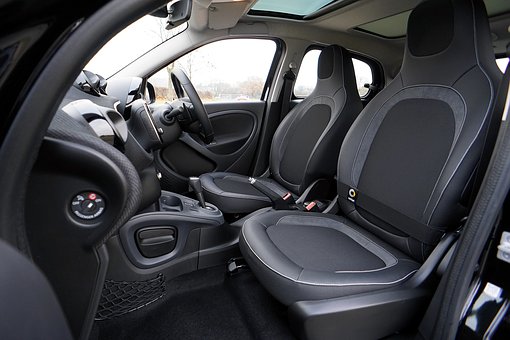
Smart surface is an emerging field of materials science in conjunction with IoT and big data. An amalgamation with electronic, biological and chemical functions can promise dynamic, reconfigurable digital control over surfaces in the physical environment. This type of technology is also called ‘structural electronics.’
Smart interiors in Automotive is a derivative of these advancements in smart surfaces. Some examples are sensors that can be applied like paint. Applications for vehicles include self-cleaning surfaces, self-healing coatings, smart glass with photovoltaics (BIPV), self-tinting windows, large-scale printed sensors for occupancy sensing, touch sensitive surfaces for robotic control, etc.
Where Have Automotive Interiors Reached so far ?
Listed here are some major Global Advancements in Smart Interiors. Structural stuff:
- Tactotek develops and licences injection moulded structural electronics (IMSE) technology and works with companies like Leonhard Kurz and has been recently licensed by Kyocera, Japan to enhance their display related products and patented Haptivity tactile feedback technology.
- ESI Automotives works with displays and in-mould electronics (IME) with light weighting as a goal especially for electric vehicles. Film technology advancement is likely to enable design freedom afforded by 3D forming capabilities that can result in more freeform displays compared to the current ones. On the downside, currently, one of the biggest challenges for the market is that there are no established standards for displays and IME. ESI Automotives, is therefore, partnering with customers to develop standards that meet and exceed the performance and reliability needs of the automotive industry.
- Leonhard Kurz is into touch controlled Human machine interface (HMIs) as well as attractive surfaces with integrated functions for the vehicle interiors. It offers variety of decoration methods such as hot stamping, in-mould decoration (IMD) or insert moulding which can be used to implement a wide variety of designs. Kurz helps with plastic-based chrome parts for instrument panels, on-board computers, navigation devices, and air-conditioning. KURZ solutions help apply partial, full-surface and even two-sided decorations on flat, curved, polygonal, small and large surfaces. Surfaces that are resistant to scratches, wear and tear, UV rays, moisture, sunscreen and cleaning agents are part of their processes. Kurz believes that capacitive sensors can create functionalities for the driver to gesture or touch.
Sustainable New Age Interiors

At present, car interiors are predominantly made of plastic due to their durability, aesthetic appeal, low density and chemical resistance – mainly made of polymer combinations. However, manufacturers are also increasingly striving to incorporate natural fibres into their materials strategy. For example, the door panelling and instrument panel cover of the BMW i3 is made from Kenaf, a fast-growing plant combined with fibres of polypropylene (PP) covered with a wafer-thin black PP decorative film that is laminated onto the surface. The resulting natural fibre-reinforced plastic (NFP) is said to have achieved a weight reduction of about 30-45%, and it is claimed to have advantages in crash events since NFPs do not splinter but rather break without sharp edges. The BMW i3 also incorporates other natural fibres elsewhere in the car interior, for e.g., the seat covers are made from 40% pure new wool – a fabric renowned for its breathability.
Companies like Yanfeng Automotive Interiors, a specialist in cabin concepts demonstrates the invisible integration of features into interior concepts. Fischer Automotive too is working on concepts where a seamless surface provides interaction, light, and haptic feedback. Morphing buttons and tactile controls are being heralded as a further way to create a better and more intuitive user experience. Minimalist cockpit is seen as a clear trend and buttons and dials being replaced by a central touchscreen has become commonplace. While touchscreens offer space-saving possibilities, designers are faced with the problem of the dangers of distracting the driver. A continuing focus of R&D is therefore on more intuitive, safer and simple control options for motorists, including the integration of haptic feedback into touch-sensitive surfaces.
The new Origo Steering Wheel concept replaces multiple mechanical controls in different locations with novel, 3-dimensional touch sensors that are integrated into the steering wheel and easily operated by thumb, providing a natural, smartphone-like interaction – with the main aim of improving safety by reducing driver distraction. It has been co-created by Canatu, Siili Auto, Rightware and TactoTek, each bringing their unique expertise to the project:
- Canatu provides its fully transparent Carbon NanoBud (CNB) film-based touch sensors that are integrated into the steering wheel. CNB sensors can be formed and moulded into any shape providing design-freedom and great user experience;
- Siili Auto designs and implements User Interface (UI) of the smart steering wheel. UI and the steering wheel physical form and innovate controls are seamlessly integrated into a unique user experience;
- Rightware is providing its HMI software tools including Kanzi UI, Kanzi Connect, and Kanzi Maps to enable rapid design, prototyping, and development of intuitive interaction models for this new concept;
- TactoTek applies its Injection Moulded Structural Electronics (IMSE) technology to design and produce smart surfaces that include circuitry, touch controls and illumination in 3D injection moulded designs.
Grupo Antolin in partnership with Walter Pack offers decorative inserts and smart surfaces based on films made from various technologies, such as in-mould decoration (IMD) and in-mould forming (IMF) among others. Their innovative surface technologies play with new materials, textures and patterns inspired by nature. They use natural materials, such as real stone, natural cork and leather and can even go a step further by combining them to create bi-material decorative inserts with a new design that offers an alternative to traditional solutions. They also use finishes and materials, such as steel mesh, carbon fibre or brushed aluminium to give a sportier character to their proposals.
Kostal Automobil Electrik is into enhancing electronic masterpieces to enable the vehicle of the future to become a living organism on the inside. Reflective surfaces turn into transparent, interactive control panels and the vehicle communicates with occupants using light signals on surfaces that were otherwise blank beforehand. The smart electronics and software behind the surfaces are invisible but highly sensitive. Switching is intuitive and takes place in a flash and the effortless reaction makes the interaction seem easy. Towards achieving their joint goal of seamless integrated mechatronic user interfaces, Kostal has pooled its know-how with Yanfeng Automotive Interiors (YFAI). Similarly, CGT (Canadian General – Tower Ltd.) is behind the Reveal smart-surfacing material that can appear via texturing to resemble wood, metal, leather and carbon fibre, etc and also act as a medium to control functions. With an intention to reduce frustration from multiple screens and button, a stretchable and light-permeable material resembling leather, with sensors, electronics and electromechanics underneath, brings the now-you-see-them, now-you-don’t morphing controls to fruition in Continental’s 3D touch display. A key goal is to reduce time spent looking away from the road.
NextInput, Inc., the leader in MEMS-based sensing, has captured the attention of the automotive industry with its disruptive and patented force sensing solutions. Presently it is regarded as the only viable solution available that is both sensitive enough to detect intent through any material and robust enough to achieve AEC-Q100 automotive qualification. NextInput is now working to bring contextual awareness through sensor inputs to the automotive cabin and its requirement becomes evident with the adoption of semi-autonomous driving technologies. The same sensors that are used to determine the driver’s intent can also be used to measure the health and wellness of the driver and judge incapacitation.

Future Gazing into Autonomous Driving
Adient has developed two seating concepts viz. for ride sharing and for privately owned autonomous vehicles. The ride sharing level 4 concept AI18 monitors the seating position of the driver and the occupant as well as their heart and respiration levels to assess their stress levels and provide solutions, whenever required – all through the intelligent front seat. The autonomous vehicles concept AI17 has an adaptive seating feature, which rotates 15 degrees inwards, enabling comfort and easy consumer interaction. The seats also greet the passengers, while entering the vehicle by rotating outwards.
Magna has built on a concept which includes three specific configurations for flexible seating intended for cargo carrying, long road trips, and autonomous ride-sharing: In the Cargo mode, the vehicle’s three rows of seats slide to the front of the vehicle on rails and nest under the instrument panel to create a large cargo area at the back. In the Campfire seating mode, the seats slide and swivel on long rails around the periphery of the interior, so occupants face each other, with three on each side and two seats at the front and rear. Finally, in the Autonomous ride-sharing mode, seats swivel and reverse on power long rails and there are seat signals that indicate which seats are available for ride-sharing.
Hyundai Motor Group, has unveiled the concept focused on luxurious features such as a super-relaxation mode for the rear passengers. In addition to this, there is an easy-access mode that ensures easy entry and exit i.e., the seats can swivel outwards.
After seating, the innovations are going around the instrument panels as well. Some examples include:
Yanfeng Automotive Interiors demonstrated an autonomous interior concept XiM17 Autonomous interiors with lounge, meeting, family and driving mode with a focus on the instrument panel. Also, along with a large overhead screen and focus on interior lighting, the company has ensured a large storage space in the instrument panel which allows easy access to passengers.
Faurecia has unveiled an innovative instrument panel concept, where the panel adapts to the changes, as per driving mode. In the normal driving mode, the driver can see the panel, which is useful for navigation, ensuring road and safety information. As soon as the autonomous mode is switched on, the display glides and moves to the centre of the panel. This ensures the display is visible for all passengers, as the screen also adapts and becomes large.
From the world of comfort driving into the world of in-vehicle infotainment. One of the open questions is how the in-car infotainment will change with autonomous driving?
There are three key factors that are driving the in-vehicle customer experience to entertain passengers:
- Increase in customer demand for a better experience
- Increase in the usage of innovative technologies like AI, IoT, and 5G
- The arrival of level 3 autonomy and progress towards level 4 and 5
Some key areas which are critical for OEMs to investigate include:
- Human Machine Interface: In this head-up-displays (HUDs) will play a crucial role, as the display in front of the driver or co-passengers will play a vital role in last-mile navigation and, more importantly, alert in case of emergency.
- In-vehicle Commerce: Increasingly customers are interested in connected commerce where they can shop, buy, and eat inside the car. In-vehicle commerce shows promising prospects and is a big market opportunity for OEMs and is expected to grow rapidly.
- Others: In addition to this, navigation, video streaming, music, gaming, and in-car voice assistants are other vital areas that OEMs are working on
Innovation is the key to autonomous driving, and it will be worthwhile to mention the leading technologically advanced OEMs and their recent innovations with respect to infotainment systems.
In Mercedes 2021 S-Class MBUX Infotainment System, the passengers in the rear can enjoy the same entertainment as that in the front. Each passenger can use their personalized entertainment system. It also has a new 3D driver display, which allows a special view and a three-dimensional effect is ensured without the usage of a 3D glass. The vehicle also has an Augmented HUD for driver assistance, which projects navigation in the windshield.
In the BMW i Interaction Ease’, along with greeting the passenger in an autonomous vehicle, interaction with the vehicle is possible using a new type of gesture control and the gaze detection system. The passenger need not learn various commands. The vehicle using intelligent AI adapts itself to the exterior environment and provides the passenger with various options of having coffee, food, etc. Passengers can choose from – Explore, Entertain, and Ease.
In the Bentley EXP 100 GT, the vehicle exterior is fitted with cameras to capture pictures and memories of previous drives. The passenger traveling can view the earlier memorable rides in the smart glass window of the vehicle during autonomous mode when on the urban commute or whenever required. The vehicle can also dispense cartridges filled with snacks, purified water, travel items, and clean clothes through a simple hand gesture. In terms of safety, the vehicle can also sense the driver’s mood by monitoring health indicators like blood pressure and head gestures and accordingly adjust the lighting, ambiance, and driving-style of the vehicle.
Autonomous vehicles will also create opportunities in the form of novel use cases of the vehicles, many times, even leading to novel business models. The business models can be based on numerous use cases and applications depending on customer needs and preferences. Looking into some of the concepts developed by players like Toyota in their e-Palette Concept, and other OEMs, it is predicted that the future will not only be ‘living on wheels’ but will also be ‘business on wheels’. Some concepts imagined include:
Mobile Restaurant – where passengers can pre-book their time slots depending on their requirements concerning food, interiors, time, and location of having a meal.
Moving Accommodation/Hotel – where the passenger can have all amenities inside the vehicle thus saving time and indirectly cost for the traveller.
Hospital on the Wheels – where the vehicle is fully equipped with all the necessary equipment and can be beneficial in case of emergencies.
Walking Fab-lab – where there is no mass-scale production and for e.g., a prototype can be prepared while the vehicle moves and collects various essential accessories required to manufacture it.
Moving Lounge – that provides passengers with a luxury experience that could be a movie theatre, a gaming experience, or even a relaxing atmosphere.
Physical E-Commerce at your Door Step – where a doorstep shopping experience can be provided without the need to commute.
All the above business models are concepts to be built in the long-term and may take more than 15–20 years to become a reality, or there can also be a case of some of them getting adopted, while others are scrapped due to business challenges.
Conclusion
While OEMs will take centre stage, Tier 1 suppliers and material suppliers will also play a crucial role in the vehicle interior value chain. However, there will be players from outside the conventional value chain as well, that will have a role to play in the autonomous vehicle interiors opportunity. For e.g., while Sony’s unveiling of its first concept car Vision-S does not indicate its entry into the car market, it showcases its capabilities in cameras, sensors, and touch screens. Therefore, the incumbents across the value chain need to assess which kind of collaborations they should forge with players that are not traditional automotive value chain players.
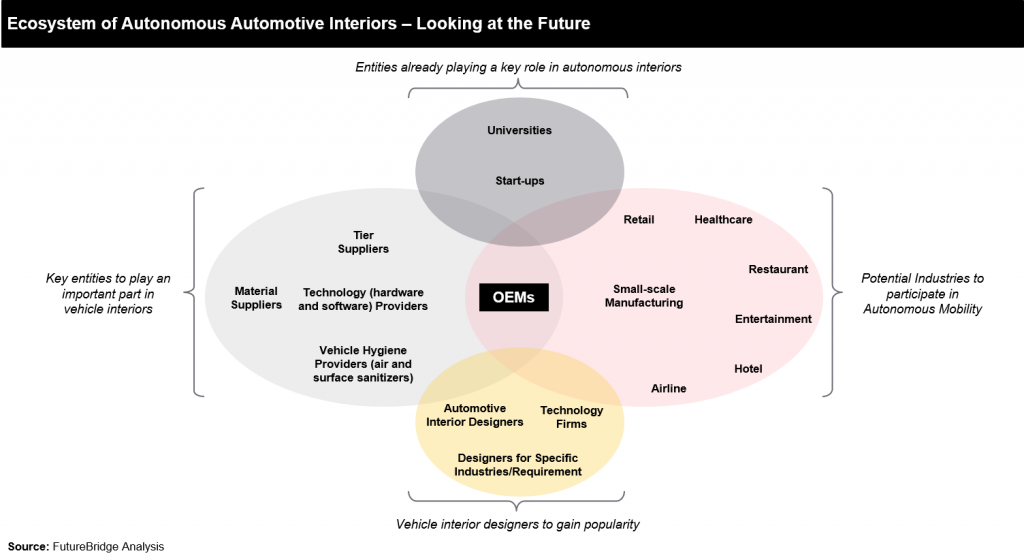
Besides the potentials of technological integration, combination of the expertise of two or more companies provides automobile manufacturers significant advantages due to the reduction of organisational interfaces along the value chain of smart surface products.
In the future, we will see growing trends for shared vehicles and self-driving cars. An interesting outlook is that the emotional ties to the vehicle will be governed more by passengers’ experience during its use than by the vehicle as an object in itself. Timing of this will partly be determined by software and safety considerations. It will be essential for OEMs to develop vehicles that excite consumers and exceed their expectations. User experience is becoming the key product differentiator for vehicle manufacturers and buying decisions by consumers are influenced by UX more than ever. The global market is growing significantly, and the value share is also increasing in India.
To know more about the opportunities in Indian automotive market please contact me at sudhir.nerurkar@quanzen.com


